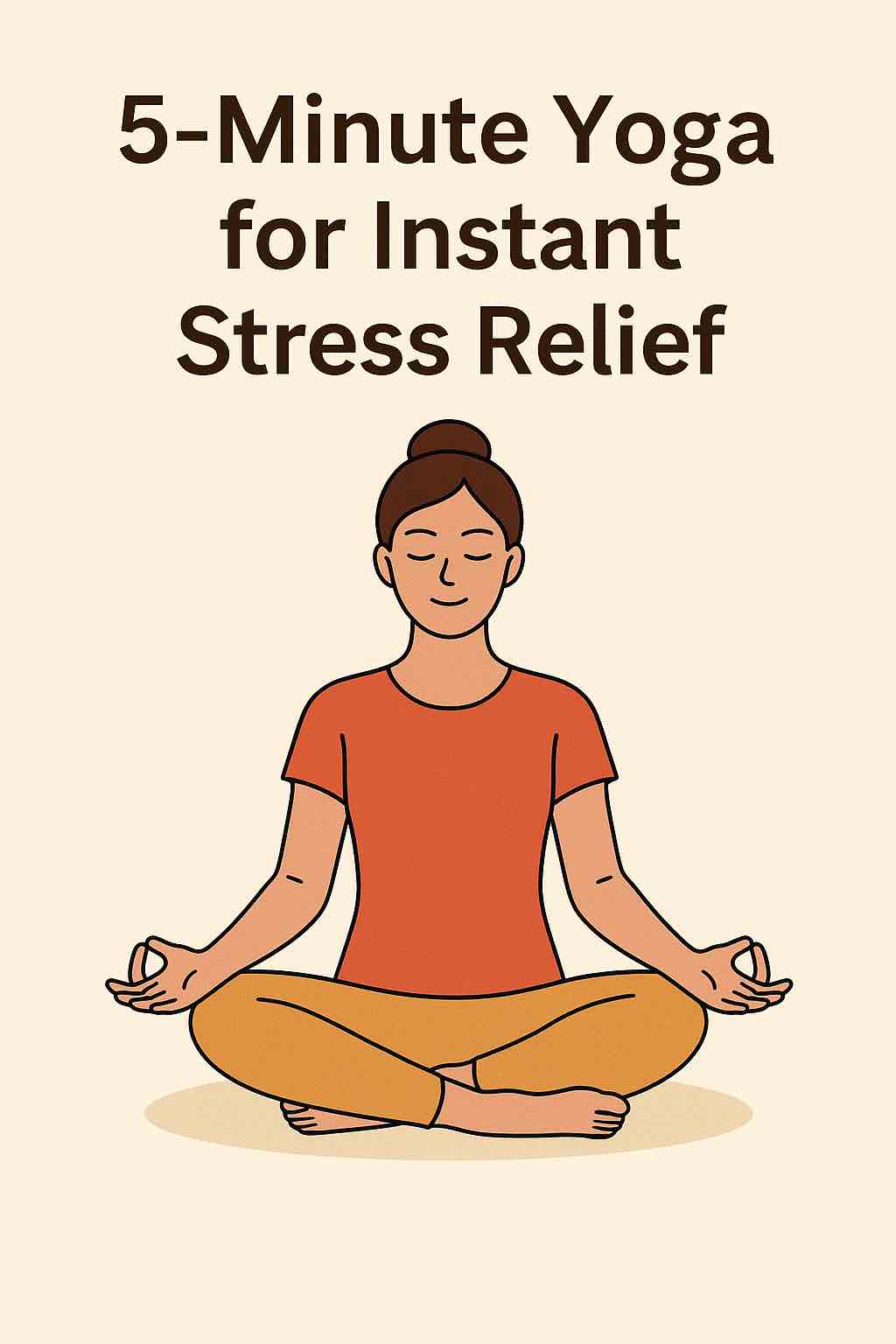
In today’s non-stop world, stress has become almost inevitable. Whether it’s work deadlines, personal responsibilities, or simply the constant digital noise, most of us carry some level of daily tension. But what if you could reset your body and mind — in just five minutes?
Welcome to 5-minute yoga for instant stress relief — a quick, effective, and accessible practice that anyone can do, anytime, anywhere.
Why Just 5 Minutes of Yoga Can Be Powerful
Many people believe yoga requires long sessions and special gear, but modern research shows even brief practices can:
- Lower cortisol (the stress hormone).
- Reduce anxiety and blood pressure.
- Relax tense muscles.
- Improve mental clarity and mood.
- Activate the parasympathetic nervous system (your body’s “rest and digest” mode).
Short yoga sessions integrate mindful breathing and gentle movement, helping to break the stress cycle quickly and efficiently.
The 5-Minute Instant Stress Relief Yoga Sequence
General Setup
- Location: Quiet space — office, home, or outdoors.
- Equipment: None required. A yoga mat or soft surface is optional.
- Attire: Comfortable clothing that allows free movement.
Minute 1 — Box Breathing (4-4-4-4 Method)
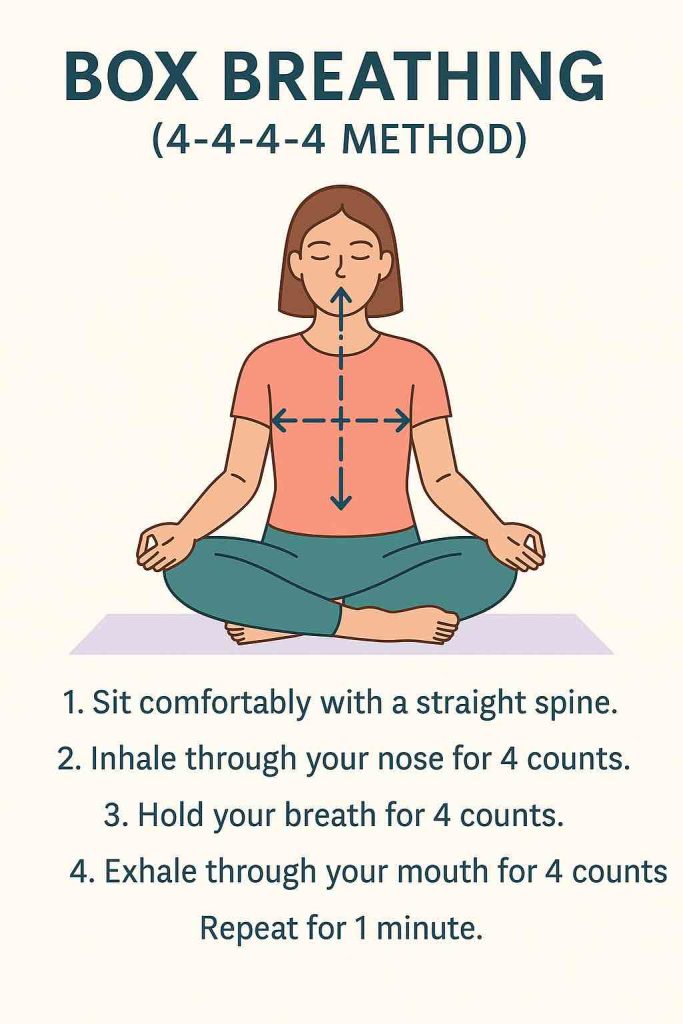
Instructions:
- Sit comfortably — cross-legged on the floor or upright in a chair.
- Keep your spine tall, shoulders relaxed.
- Inhale through your nose for a count of 4.
- Hold your breath for 4 counts.
- Exhale slowly through your mouth for 4 counts.
- Hold your breath empty for 4 counts.
- Repeat this cycle for 60 seconds.
Purpose:
Calms the nervous system, reduces heart rate, and centers your mind. This is one of the fastest ways to activate your body’s relaxation response.
Tips:
- If holding the breath feels uncomfortable, shorten the holds or skip them.
- Keep breaths smooth and gentle — avoid straining.
Minute 2 — Seated Neck Rolls
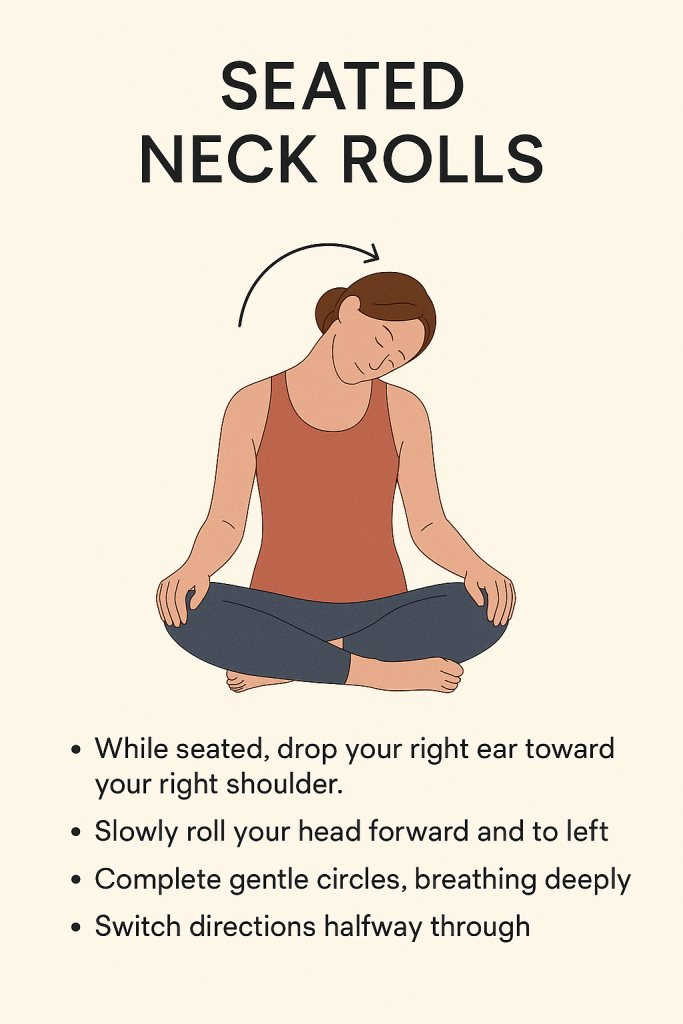
Instructions:
- Remain seated.
- Gently drop your chin toward your chest.
- Slowly roll your head to the right, bringing the right ear towards the right shoulder.
- Continue the circle, rolling the head back and to the left.
- Complete 2-3 slow circles in one direction.
- Reverse and repeat on the other side.
Purpose:
Releases tension in the neck and shoulders — areas where most people carry stress.
Tips:
- Move slowly and mindfully.
- If any movement feels uncomfortable, reduce the range of motion.
Minute 3 — Seated Forward Fold (Paschimottanasana)

Instructions:
- Extend both legs forward while seated.
- Inhale, lengthening your spine and reaching your arms up.
- Exhale, gently fold forward from your hips, keeping your back straight.
- Let your hands rest comfortably — on your shins, ankles, or feet.
- Relax your neck and jaw.
- Hold for 60 seconds, breathing deeply.
Purpose:
Gently stretches the spine, hamstrings, and back while grounding the nervous system.
Tips:
- Avoid forcing yourself deeper into the stretch.
- Use a cushion or rolled towel under your knees if needed.
- Keep your breath slow and steady.
Minute 4 — Cat-Cow Flow (Marjaryasana-Bitilasana)
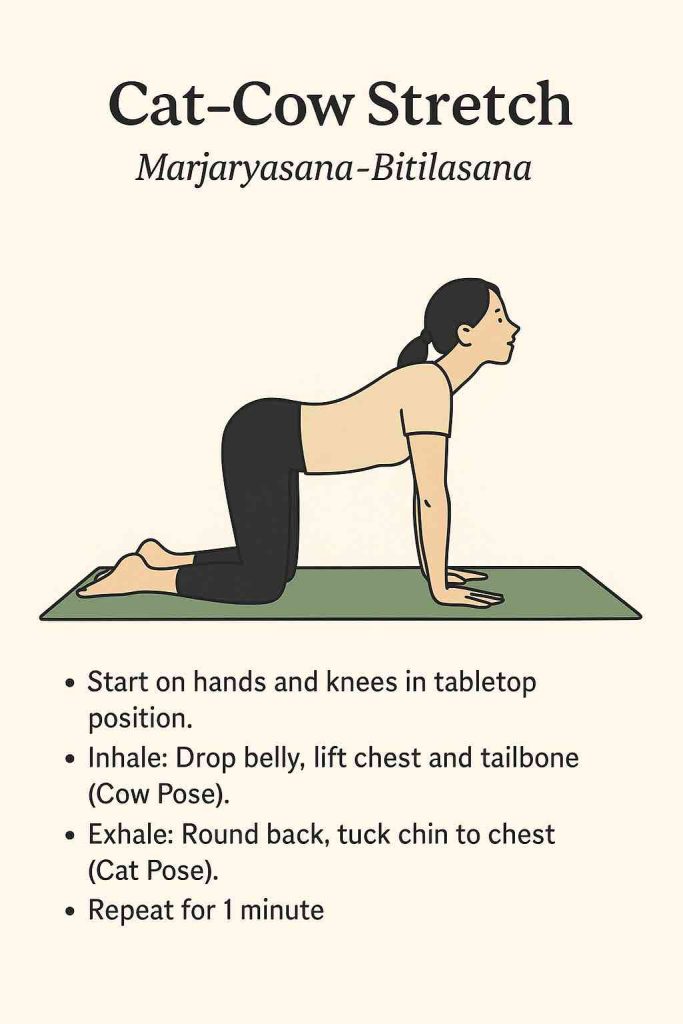
Instructions:
- Come onto hands and knees in tabletop position (shoulders over wrists, hips over knees).
- Inhale: Drop your belly, lift your chest and tailbone towards the ceiling (Cow Pose).
- Exhale: Round your spine, tuck your chin to your chest (Cat Pose).
- Flow between Cat and Cow slowly, matching your breath.
- Continue for 60 seconds.
Purpose:
Mobilizes the spine, releases back tension, and synchronizes movement with breath — a key to calming the mind.
Tips:
- Keep movements smooth.
- Avoid hyperextending your neck — gaze softly forward during Cow Pose.
Minute 5 — Child’s Pose (Balasana) with Affirmation
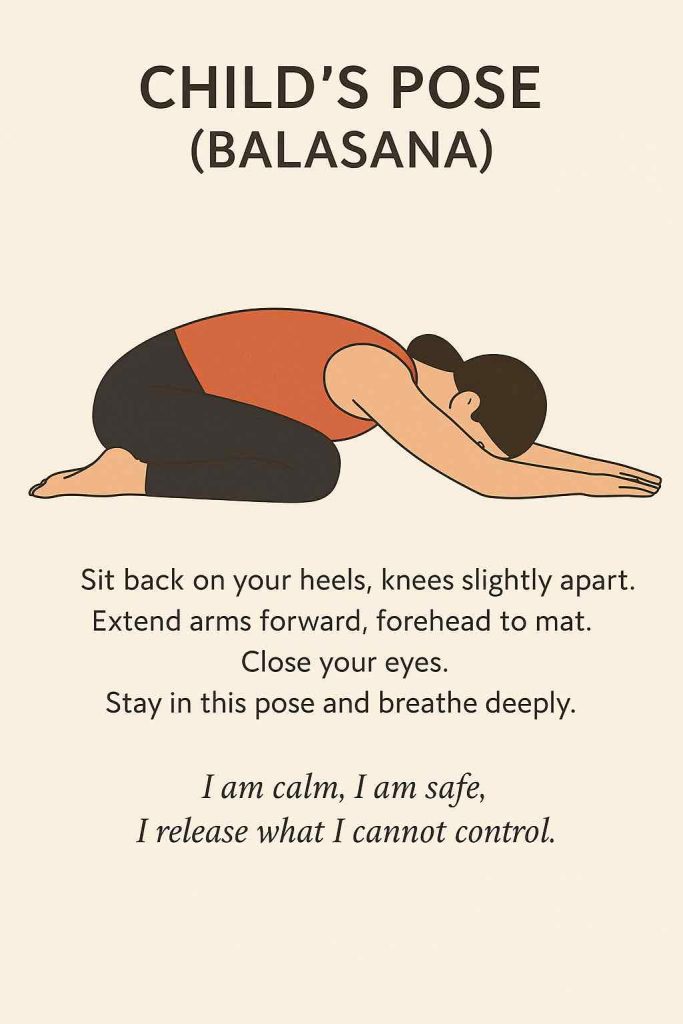
Instructions:
- Sit back on your heels, knees slightly apart.
- Stretch your arms forward and bring your forehead to the mat or stacked fists.
- Close your eyes.
- As you breathe, silently repeat an affirmation:
“I am calm, I am safe, I release what I cannot control.” - Stay in this pose for 60 seconds.
Purpose:
Deep relaxation, grounding, and mental reset. Allows the body and mind to fully absorb the calming effects of the previous poses.
Tips:
- If knees are uncomfortable, place a cushion between thighs and calves.
- If forehead doesn’t reach the floor, stack fists or use a pillow.
Safety Considerations
- Avoid any movements that cause pain or discomfort.
- Those with specific injuries (spinal, neck, knee) should modify or skip poses as needed.
- Consult a healthcare professional if you have medical concerns before beginning any new exercise program.
Enhancing Your 5-Minute Practice
- Consistency is key. Practice daily, even during busy schedules.
- Environment matters. Dim lights, calming music, or aromatherapy can enhance relaxation.
- Mindset is everything. Approach the practice with full presence; even five minutes of mindful attention can work wonders.
The Power of Micro-Practices
When stress hits, many people feel trapped — waiting for the “right” time to relax or for stress to resolve on its own. But small, intentional practices like this 5-minute yoga sequence can quickly shift your state of mind and body, creating pockets of calm even during the busiest days.
Remember:
You don’t need an hour. You just need five mindful minutes.
Try this today — your nervous system will thank you.
Bonus: Quick Summary Chart
| Minute | Practice | Key Benefit |
|---|---|---|
| 1 | Box Breathing | Immediate calm |
| 2 | Neck Rolls | Tension release |
| 3 | Forward Fold | Grounding & stretch |
| 4 | Cat-Cow | Spinal release |
| 5 | Child’s Pose | Deep relaxation |
✅ 10 FAQs for the Blog
1️⃣ Can 5-minute yoga really reduce stress?
Yes. Even brief yoga practices activate your parasympathetic nervous system, lower cortisol, calm your mind, and release muscle tension. Research confirms that short, mindful breathing and movement can significantly reduce perceived stress levels.
2️⃣ Is 5 minutes of yoga enough if I’m very stressed?
While longer sessions offer deeper benefits, 5 minutes can provide immediate relief and help interrupt the stress cycle. You can always repeat the sequence multiple times if you need a longer practice.
3️⃣ Can I do this yoga routine at my desk or workplace?
Yes! Most of the poses can be easily modified for a seated position at your desk. Box breathing and neck rolls are especially office-friendly.
4️⃣ Do I need to warm up before starting?
For this gentle routine, no formal warm-up is needed. The sequence is designed for low-intensity movement with a gradual build-up of flexibility and relaxation.
5️⃣ What if I can’t touch my toes in the forward fold?
That’s perfectly fine. The goal is not to force flexibility but to create a comfortable stretch. Rest your hands on your shins, ankles, or thighs—wherever feels right for your body.
6️⃣ Is this routine suitable for beginners?
Absolutely. This 5-minute yoga sequence is beginner-friendly, requires no prior experience, and includes simple, low-impact poses.
7️⃣ How often should I practice this?
Daily practice is ideal, but even 2-3 times per week can provide noticeable stress relief. Consistency is more important than duration.
8️⃣ Can this routine help with anxiety or sleep?
Yes. The breathing techniques and calming postures help quiet the mind, making it a helpful tool for managing anxiety and improving sleep quality.
9️⃣ Are there any risks or precautions?
Listen to your body. Avoid poses that cause discomfort or pain. If you have existing injuries or health conditions, consult your doctor or a certified yoga instructor before beginning.
🔟 Can I combine this 5-minute routine with other workouts?
Definitely. This routine works well as a warm-up, cool-down, or standalone stress reliever. You can also pair it with meditation, walking, or strength training.










